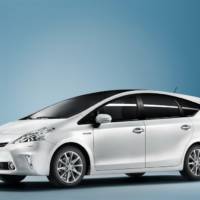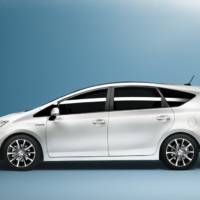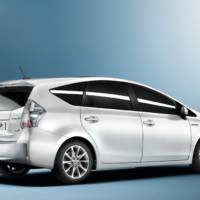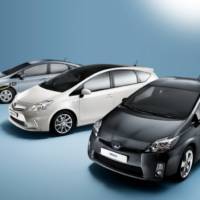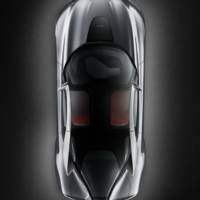The Toyota Prius Plus premiered in Geneva today, and this new seven-seater which represents Europe’s first Hybrid MPV will go on sale in the first half of 2012.
Just like the Yaris HSD Concept, the Toyota Prius Plus is all about low emissions and consumption, but this time combined with family versatility through its generous space at the interior which has been configured in three independent, split-folding second row seats, and a 50:50 split fording third row.
The exterior indicates its close relationship with the Prius hatchback, with the triangular silhouette allowing a drag coefficient of only 0.29, which as you may know, also helps in maximizing efficiency.
The Toyota Prius Plus is equipped with the latest generation HSD (Hybrid Synergy
Drive) which includes a lithium-battery pack of compact dimensions fitted beneath the second row seats. The car’s powertrain alloys the driver to choose between tree ‘on-demand’ driving modes, which are EV, for electric power only, ECO which means extended range driving, and POWER mode, which ‘
sharpens response and boosts performance’.
Toyota press release :
Europe’s first seven-seat full hybrid revealed at Geneva motor show
KEY POINTS
* Geneva debut for new Prius+ full hybrid MPV
* Lowest fuel consumption and emissions of any seven-seat vehicle on the market
* Designed from the ground-up, while retaining key Prius family styling cues
* First non-plug-in Toyota hybrid to use lithium-ion battery pack
* Due for European market launch in first half of 2012
* Positive initial response from Prius Plug-in lease demonstration programme
The new Prius+ makes its debut at the 2011 Geneva motor show, representing further expansion of Toyota’s Prius family. It is the first full hybrid model in Europe to offer seven seats, combining family friendly versatility with strong environmental performance and advanced technology.
As its name suggests, Prius+ provides a significant increase in space and passenger accommodation compared to its sister hatchback model. There are three independent, split-folding second row seats and a 50:50 split-folding third row. In spite of the increase in size, it retains the fundamental performance benefits associated with Prius, including the lowest fuel consumption of any seven-seater on the market.
Set to go on sale during the first half of 2012, Prius+ is a new vehicle, designed from the ground up. Its exterior represents an evolution of the established Prius design, rather than simply being an elongated version of the standard model.
The look of the new car is characterised by its extended roofline with an integrated panoramic (fixed) sunroof. It retains the Prius triangular silhouette and achieves a Cd 0.29 drag coefficient. The trapezoidal front end incorporates sharp-edged headlamps, flat, vertical ‘aero’ corners that reduce air turbulence, and an enlarged lower grille to improve aerodynamics and engine cooling.
The rear of the car features a top-hinged tailgate, intricate lamp clusters and a roof spoiler that further manages smooth airflow.
Prius+ is equipped with the latest generation of Toyota’s Hybrid Synergy Drive and is the first Toyota non-plug-in hybrid to use a lithium-ion battery pack. The compact dimensions of this battery – first introduced in Prius Plug-in – allow it to be contained entirely beneath the second row seats, which means passenger and loadspace and the vehicle’s interior flexibility are unaffected.
As in the standard Prius, Prius+ features three ‘on-demand’ drive modes so that capabilities of the hybrid powertrain can be fully exploited. EV mode allows the car to be driven on electric motor power alone, resulting in zero fuel consumption and tailpipe emissions; ECO mode maximises hybrid system efficiency and fuel economy, while POWER mode sharpens response and boosts performance.
Toyota Prius Plug-in
Toyota also aims to bring Prius Plug-in to the global market in the second half of 2012 and in preparation for this around 600 vehicles are currently taking part in demonstration lease programmes worldwide, including 20 in London. These projects are designed to assess every aspect of real-world use and verify the car’s overall environmental and technological performance before going on sales
Initial feedback from European lease project customers is very encouraging. Most of those surveyed have reported that the car exceeds their expectations, in many cases by a significant degree. Two thirds have expressed themselves fully satisfied with the car’s EV driving range, which in real-world testing has exceeded nine miles.
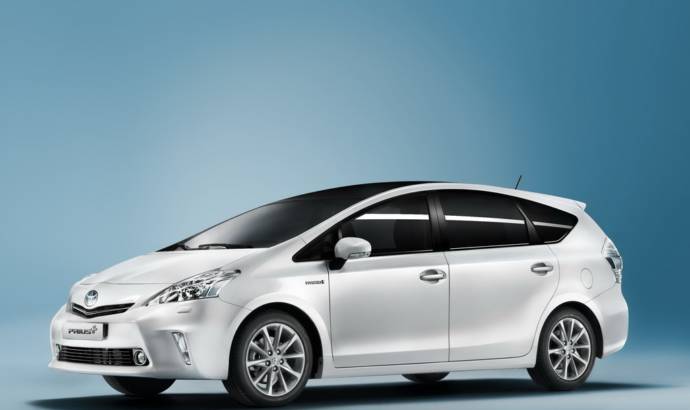
01 Mar 2011
0

